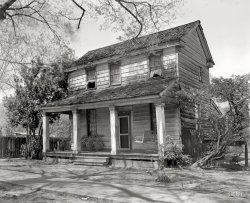
MAY CONTAIN NUTS

Search Shorpy
SHORPY ART

Framed or unframed, desk size to sofa size, printed by us in Arizona and Alabama since 2007. Explore now.
Join and Share
Ad-Free Shorpy
Shorpy is funded by you. Patreon contributors get an ad-free experience.
Learn more.

Recent comments
- Freeze Frame
- Texas Flyer wanted
- Just a Year Too Soon
- WWII -- Replacing men with women at the railroad crossing.
- Yes, Icing
- You kids drive me nuts!
- NOT An Easy Job
- I wonder
- Just add window boxes
- Icing Platform?
- Indiana Harbor Belt abides
- Freezing haze
- Corrections (for those who care)
- C&NW at Nelson
- Fallen Flags
- A dangerous job made worse
- Water Stop
- Passenger trains have right of way over freights?
- Coal
- Never ceases to amaze me.
- Still chuggin' (in model form)
- Great shot
- Westerly Breeze
- For the men, a trapeze
- Tickled
- Sense of loneliness ...
- 2 cents
- Charm City
- What an Outrage
- Brighton Park
Member Photos
The Shorpy
Print Emporium
Print Emporium
Search Shorpy
Search results -- 30 results per page
- Jell-O Shot: 1925
- ... mercantile (still open) was my first stop on fishing and hunting trips in the '70s.
It's amazing to walk into such a small store and ... Posted by Dave - 09/13/2011 - 2:41pm -
![Jell-O Shot: 1925 Washington, D.C., circa 1925. "F.G. Lindsay store." With some nice Jell-O promotions scattered about. National Photo glass negative. View full size.
Well stockedLots to look at here, from meat to washboards. And this POS display too.
Familiar brandsAnd they are still around today. I could find several Nabisco products, Diamond Crystal Salt, Lava, Sunmaid Raisins, Kellogs on the top right, Quaker products, Heinz.
For all your popcorn machine needsC. Cretors & Company is still in business
3243 N California Ave, Chicago
www.Cretors.com
Clown-powered Popcorn CartsThe things you learn on Shorpy!
I always thought those popcorn carts with the laboring clown were invented by Disney as gizmos for his theme parks. Oh well. The model in the picture dates from 1909 and if you'd like to see it in color, you can find a photo here:
http://www.oldtoyz1.com/steamengines.html
B & B supplySix years earlier, this must be the place the Junior Marines got their basket and brooms.
I wonderwhat time of year this was taken. Christmas decorations are up, but the windows are open. Either it was a balmy day for D.C. or that place had a heck of a heater, I'm thinking.
I spyArgo corn starch as well. It's still around today.
Debit or creditI'd like to pick up a few things, but I'm a little light on cash today. Maybe you can point me toward your ATM?
Always facing frontWhen I was a teenager I worked in some of my brother's grocery stores for a few summers. In a well marketed store you will always find the canned goods "faced," meaning every label must be facing forward. This store was immaculately kept and displayed. What a beauty. Back in those days there was only one way to run a mercantile -- the right way.
My great-grandfather owned the first mercantile in Wallowa, Oregon, many years ago in what is still a Wild West sort of rural community of cattle ranchers and Indians. The old mercantile (still open) was my first stop on fishing and hunting trips in the '70s.
It's amazing to walk into such a small store and see it filled with so many items. You can buy anything you could possibly need from groceries to farm feed, cowboy boots, saddles and tack, cast iron skillets, pot bellied stoves, fishing supplies, flannel coats, yarn, bolts of cloth. Sitting on the old wooden front porch sipping on a soda and remembering great-grandpa. Life was good.
MiscellanyThat is the most mysterious bucket of whatever I've ever seen. And it's the most out of place pile of ? right in the middle of a most tidy store.
To me it looks like it could be scraps of wax and or tallow.
However, there also looks to be a handle from a cabinet or drawer mixed in, as well as a door knob. bones, scraps of meat and paper.
Looks like a pail of garbage that someone forgot to throw out.
D.C. WeatherThere's a reason for the expression "If you don't like the weather in D.C., just wait a minute." It can be 25 and snowing on December 10th and 78 and muggy on the 11th. So it wouldn't be unusual to see windows open at Christmastime.
Bucket o' ???Any idea what that bucket might be full of?
Re: Bucket o' ???Perhaps a variety of natural sea sponges.
#3 Bucket o' ???Looks like assorted hard candies. Wouldn't be Christmas without them.
"Tokio"Containers near the back on the right -- "TOKIO." Any clues as to what's in them?
[Toilet paper. - Dave]
Tokio mystery containersTokio is an old fashioned spelling of Tokyo. I expanded the photo as much as possible and the angled writing on the right hand side seems to say "Grade A". The word at the bottom appears to be "Flour."
My guess is: Tokio Grade A Flour, although I had to laugh at Dave's suggestion that it was toilet paper. No one is that full of .... oh well, never mind.
[No mystery. The wrappers say TOKIO TOILET TISSUE. - Dave]
(The Gallery, D.C., Natl Photo, Stores & Markets)](https://www.shorpy.com/files/images/32628u.thumbnail.jpg)
- Cooks on Wheels: 1950s
- ... Gray Ghost The gray dog is a Weimaraner, originally a hunting dog owned by German royalty. They were first brought to the US in the ... Posted by Tony W. - 03/30/2012 - 3:02pm -
![Cooks on Wheels: 1950s Bill Bliss and his family again, enjoying a little outdoor cooking sometime in the mid-fifties. I'm not sure where this is but I'm guessing somewhere up the Pacific coast. 35mm Anscochrome color slide. Here's another photo of their trip. View full size.
I never got it.I'm talking about the "craving to go camping" gene; apparently my physiology deleted permanently the instinct to want to live in the wild. I don't mind an occasional one-meal picnic or an afternoon at a civilized park facility with all the amenities but I could never understand bringing half of one's possessions on a trip to attempt to cook, eat, sleep, bathe and evacuate in the woods, especially when you have all the comforts of home (at home) and don't really need to live with wild critters, insects, nasty weather, lack of hot water and all sorts of possible unknown hazards such as being stranded alone in a primitive setting. Call me an old grouch, and there is no disrespect intended for those whe love it, but I still don't get why people do it.
Happy CampersIt's not cheating to bring the comforts of home with you camping. Still go camping all the time with my neighbor's VW Bus with kitchen built in and pop out tent (similar to what's pictured) and it's a blast. Oh, and new guy here. Been following this site for a week now, always one of my morning stops.
Cat food?Tell us more about your selections for camping "eats."
Meals on wheelsI had no idea those kinds of trailers housed a traveling kitchen, this one stocked with Ritz crackers, no less. Bill Bliss and I could have shared wardrobes.
MeowI see two Dogs, a Boy and two Women, no Cats though. I'm guessing the box was just being used as a container for other stuff?
CatfoodI'm pretty sure it's just a box for holding stuff.
Eating at the "Ritz"Actually, the teardrop style camper (so named because of its shape) was quite popular in the day. In recent years, it has made a comeback. Just do a search for the phrase "teardrop camper" and you can find hundreds of websites that offer everything from basic construction plans to fully macked out designs that are fit for a king. As for the Ritz crackers; from using them for mini-s'mores to crumbling them into my tomato soup to feeding the stale ones to the critters, they will always have a place in my camping supplies.
Gray GhostThe gray dog is a Weimaraner, originally a hunting dog owned by German royalty. They were first brought to the US in the 1930s and became quite popular by the 1960s. I have owned two and helped train many. Their nickname as noted above is "the gray ghost."
[Also noted as the sweater-wearing models of William Wegman. - Dave]
Kitchen on wheelsA decade or so later we crossed to country in an Impala wagon with a massive kitchen box in the back, more or less like this except that the Coleman stove had to find someplace else to sit when cooking. And our tent was, well, a bit more ship-shape (to mix a metaphor). Other than that, camping had hardly changed. The weight of all this plus parents-and-four-kids was enough that my father installed helper spring on the back, and even then on the road to Mogollon he bottomed out so hard that he stopped to make sure we still had a rear axle. A decade after that, and nylon had conquered all, and then came Gore-tex.
Simple joysNoting the lantern, it looks like a Coleman dual fuel or could be a kerosene type. I've just recently purchased a North Star dual fuel. It provides as much light as my two LPG lamps combined. Sometimes old technology is better than you expect. We still holiday like this as a family just as I did in the 60s. Canvas has given way to poly tarps & nylon tents; the ice boxes hold ice for 10 days; other than that it's still the same simple fun & we have no bears to worry about in Australia.
We had a English made kerosene Tilly lamp when I was a kid, you had to preheat the mantle with methylated spirits & pump the pressure tank up, the best thing about these kind of liquid fueled lamps is they are less noisy then the high pressure LPG lanterns
I want that lantern!I'm pretty sure the Coleman is a Model 220. The nickel-plated tank indicates that it is probably a Canadian model. It also rules out dual fuel, as that technology was then reserved for the military, and those lanterns were all green.
If it is a kerosene model, there will be a metal cup affixed to the base of the generator tube. You fill that with alcohol to preheat the kerosene to vaporization temperature. This is not necessary with the more volatile white gas.
Another use for Ritz CrackersMaking an apple pie. Well, more like an "apple" pie, as it doesn't actually contain apples, instead using crumbled Ritz Crackers as the main filling. But it *does* taste almost the same as a real apple pie. That's because when you eat apple pie you mainly taste the lemon and cinnamon, and the Ritz version has these in abundance.
Billy has a boo-booOr at least what appears to be a bandaid on his temple.
Reply to: I never got it.I don't think camping is a genetic trait, but it may have something to do with your past. Can I assume you didn't go camping much as a child? Or perhaps you went, and had a bad experience? I didn't get a lot of chances to go camping as a child, but I cherished the opportunities I had. There's something special about sitting around a campfire on a starry night; singing songs, often with people you just met, listening to the kids laughing, smelling the wood smoke, and eating s'mores. Peace and relaxation come differently to different people. Many of my friends enjoy camping, and for different reasons: some want to get away from "civilization" and kick back and just relax with friends; some enjoy "roughing it", and the challenges that nature brings; and still some feel they are working out the kinks in their preparation for a future world holocaust. Camping out can be fun, if you choose to let it be. I even have friends whose kids like "camping out" in a tent set up in the living room.
Little black ghostThe grey ghost is lovely, but the little black dog is the spitting image of my little dog Patsy, a Schipperke mix who lived to the ripe old age of 17 and enjoyed many a camping trip with me and my boys and many friends. This dog is even curled up like Patsy would, taking a snooze before somebody said, hey! Let's go for a walk! and then she would wag herself from top to bottom and head off for an adventure.
Camping, and kids, and dogs. Nothing like it.
(ShorpyBlog, Member Gallery, Tonypix, Travel & Vacation)](https://www.shorpy.com/files/images/campsite.thumbnail.jpg)
- Kitchen Nightmare: 1937
- ... My Grandma Edna's husband had been killed in a hunting accident and she had two boys, Howard & Larry Simplot. Together ... Posted by Dave - 06/01/2013 - 3:15pm -
![Kitchen Nightmare: 1937 June 1937. "Child of Earl Taylor in kitchen of their home near Black River Falls, Wisconsin." Photo by Russell Lee, Resettlement Administration. View full size.
SpeculatingNobody knows what was really going on here but there are so many possibilities. After looking at Michael L's comment and photo, it seems the kids are all withdrawn, shy and very timid so they may be afraid of Dad. Or perhaps one parent had a mental or physical illness and the other parent was expected to do all the work alone, impossible for one individual with seven needy kids a year or two apart. There were no disposable diapers, baby wipes, cleaning wipes, convenience foods or Swiffers. Both parents are young, could have been a teen marriage and Dad appears to be indifferent and disinterested in any of them while Mom looks embarrassed and stands away. Clearly there is extreme poverty there but for whatever reason, keeping a neat, clean home and nine people contented was not possible. A family needs both a head (usually the father) and a heart (usually the mother) and together, both need to be strong enough to handle the needs of a family of nine. There were probably even more future babies to come but none of us know the real problems here. It may be a heartbreaking story but we can only hope it had a happy ending. Seeing this picture should make you stop feeling sorry for yourself and count your blessings, knowing things can always be a lot worse.
In the South, we say"They're doing the best they can, bless their hearts."
maybe, maybe notMaybe they are slackers, maybe not.
Obviously, dyfunctionals and messies are not a new phenomenon.
My personal take would be that the parents have other and larger problems besides being dirt-poor. Back then it could have been moonshine, today maybe it would be meth.
The kid's bibs could need a wash, too.
On second thought, please let me elaborate and add some other possible / probable problems:
- Just being overwhelmed by adverse conditions. It might be the economy, after all.
- Living way out in the boonies where nobody ever drops by, nobody cares, no social checks and ballances, no Joneses around to whom one might need to keep up with.
- Or having lost all pride.
- Any number of others.
As I recallThere were several posts of the Taylor homestead. Most if not all of their children grew up and had families of their own. Probably without any government assistance.
[Actually, many if not most of these people were Resettlement Administration clients. That's why their photos are in a government archive. - Dave]
Nightmare is rightThere's poor and then there's poor.
Needs a woman's touchI'm guessing that Mr. Earl Taylor may have been a widower.
[Nope. - Dave]
No excuse for this filth. I knew many very poor people when I was growing up in Europe, but that did not preclude their keeping a neat, clean house.
Nightmare is Wrong.Just because you are poor doesn't mean you have to live like a filthy pig. The parents are slackers.
So which one of them is Andy?You know, Opie's Dad.
Hygiene did not come from the genesSome people forget that the concept of hygiene is not something that stems from spontaneous generation, it is taught until is ingrained into the culture. These parent’s parents –obviously as poor as them- grew up into the XIX century when the concept of hygiene just began to get hold and just in the most urban and educated areas. Education apart, isn't that obvious also that these folk didn't have all the modern appliances and cleaning products that today we take as granted and cheap? Or that caring for seven children –no pills back then- set the priorities in other orders? When all of the children are barefoot, how come people get disgusted or offended by untidiness or some dirt? Furthermore, think that unless you have royal blood (and to a certain degree), all your ancestors lived in worse conditions.
Too busyThe Mrs probably had a busy week and got a little behind on the house cleaning.
Slackers or notThis photo and the accompanying family scene certainly do reveal a nightmare of poverty during the Great Depression. The little boy doesn't look particularly dirty to me, especially considering the fact that he has no shoes. He apparently had just wet his pants (which certainly haven't had time to dry), but I know that a child as young as he might do that about 60 seconds after being changed.
Consider the likelihood that there is no indoor plumbing or no running water. The kitchen doesn't look any more dirty than the kitchen we can see in Homeless Cooking, when you account for the fact that one uses diesel/gas and this one uses wood or coal which is a much dirtier heat source.
And apparently this family has managed to hold out renting an actual building to live in at the time of this photo rather than live in a tent as pictured in the referenced second photo. Does that make the parents bigger or lesser slackers than those who live in tents?
I know it's an American passtime to blame poor people for all their problems (and often for society's problems) but if you haven't walked in someone else's shoes and don't have any details of their circumstances other than their abject poverty during the Great Depression, please try to restrain yourself from condemning other folks. And I've seen pictures of filth from Europe before -- do I really have to provide links to prove that?
Lastly a thought: Consider a wealthy family with inherited money of this period who don't work and who pay other people to do all their cooking, cleaning and child caring. Slackers, or not?
What might have beenIf they could have cleaned up that oven.
My mother always saidsoap and water are cheap, no excuse for filthy, that little infant standing in his own filth and pouring in more tugs at my heart. The mother must be overwhelmed to allow this condition, and to let it be photographed. RIP Dear Lady, assuming she has gone to her final reward.
Not quite a thing of the pastI have witnessed similar scenes in rural Maine not too long ago. Poverty and neglect knows no age.
Sometimes you just can't do it all.The place looks awful. But the little boy looks clean and well-fed, and he looks like he was loved and cared for. I have seen similar in the year 2013.
Doing what they canA lot of judgment going on here on Shorpy, unfortunately. I agree the kitchen is awful - no argument there. But I did a little research on the family.
Earl Taylor was a younger son of a farm family in the area (1910 census). By 1920, he was 22 and the only one left at home (1920 census). In 1930, his father had died, and his mother was the widowed head of household. Earl had also been married and widowed, and he lived on the farm with his mother and his three children, two sons and a daughter (Earl Jr., Albert, and Evalina). I believe they are the three oldest kids in the family photo Dave posted (1930 census). Earl apparently remarried in about 1921 to a woman named Edna (pictured), who was a widow with two sons (Howard and Garvey Simplot, the two on the far left, I'm guessing. He was 43 and she was 29 in 1940 (1940 census). Together, they had the two smallest boys in the photo, Ronald and Ersel, followed by another son, Garry, around 1938. The little boy in the kitchen photo would be Ersel, age 2 at that time. The census shows the father as a laborer for the WPA. Their home was valued at $200 and his earnings for 48 weeks of work in 1939 was $420.
No conveniences... a large (blended) family, extreme poverty, and little hope -- pretty bleak picture. But I think they also probably had a lot of love going on. I hope they eventually did well.
These poor people are my family.The little boy in the kitchen was my father. You have his name wrong, it was not Ersel, it was Cecil Taylor. Yes my fathers family was extremely poor and my grandmother was not the best house keeper in the world, but she was a very hard worker as was my grandfather. While they were strict with their children they were very good loving parents. Their circumstances did improve after the depression. When my grandfather Earl married my grandmother Edna he had four children, Earl Jr., Albert, Evelina & Duane. His first wife had died after giving birth to my Uncle Duane as she had a burst appendics that they thought was just after birthing pains, after this happened he sent the two smaller children to live with his wifes sister, this was before he had met my grandmother. My Grandma Edna's husband had been killed in a hunting accident and she had two boys, Howard & Larry Simplot. Together they had Ronald, Cecil, Gary, Jackie, Roger and twin boys Tommy & Terry (Terry died as a baby). They also cared for my Grandpa Earl's mother and took in other family members during these tough times. They had no indoor plumbing, no electricity & heated with wood at the time of this picture. Thank you for sharing the pictures, I don't think I had ever seen that particular picture of my dad.
(The Gallery, Kids, Kitchens etc., Russell Lee)](https://www.shorpy.com/files/images/SHORPY_8b36611a.thumbnail.jpg)
- Flying: 1972
- ... That appears to be a steel can.
Sleazy Riders Hunting for hippies, no doubt.
Hey, hold my beer and watch this -- ... Posted by Dave - 10/05/2010 - 6:11pm -
![Flying: 1972 "Cornett family, Kentucky, 1972." A Cornett boy and one of his Buds in that Chevy convertible we saw earlier. Print from 35mm negative by William Gedney. Gedney Photographs and Writings Collection, Duke University. View full size.
It's safer than textingAt least he has his eyes on the road.
Been there, done alot of thatAh youth, 1977, '66 Olds Toronado, Strohs or Bud, occasionally Schoenlings Little Kings cream ale, Salems by the carton and Craig cassette stereo cranked up to the top, probably Doobie Brothers, or Marshall Tucker band. Thank heavens that damn thing had the Divine Intervention Option or I would have been a goner, wish I could do it all over again. Keep up the posts, could have had a ball with these guys even though I'm From Ohio.
ShiftlessWhere did the shift lever go?
[Moved downstairs, I'll bet. - Dave]
MemoriesHand cranked car windows.
Chevy Super SportThat tachometer might mean this was a Chevy Super Sport. You could get it with a column-mounted manual shift although this probably had an automatic transmission that was switched out in favor of a three-speed manual with floor shifter. As would befit any self-respecting good ole boy.
KeylessIt's a brave photographer who gets into a car that's been hotwired with a man who's been drinking.
[The key would be in the ignition, which would be on the dashboard (he said, steadying himself on his cane). The hole is where the shift lever used to be. - Dave]
Well, this answers one question... Do any of the brothers own a shirt?
Vent WindowWhat's missing from today; really miss them.
The Hazards of Duke?Speeding down the road, chugging beers. I bet they rarely opened the doors to get in or out -- just slipped through the open window.
'64 SSIf this is the same car shown earlier it's not a Super Sport. The SS had a single, wider side-spear trim, not the U-shaped twin spear in the photo. Interior would have has a SS trim button on the door and a factory installed floor shift, so there would never have been a column shift. As for the tach, it was an option, my high school '64 Super Sport never had one, had to mount a Sun tach on the dash (not that it was needed with that old Powerglide. Thanks for steadying that cane.
Gulp!That appears to be a steel can.
Sleazy RidersHunting for hippies, no doubt.
Hey, hold my beer and watch this --Sometimes the last words heard on the "black box" recorders in these cars of the South.
Beer / PitchingReminds me of the good old early 70's - tossing empty Miller Pony bottles at highway signs while standing up in my friend's 1970 Grand Prix sunroof - careening down a twisting highway of course. It's a wonder I'm still here!
Here's JohnnyBefore I even saw the Dukes of Hazzard comment (and not necessarily connected to it), I thought this guy had a serious Johnny Knoxville thing going on. And not just because he seems to be doing something stupid. Great photo.
(Cars, Trucks, Buses, Cornett Family, William Gedney)](https://www.shorpy.com/files/images/KY0905-lrg.thumbnail.jpg)
- Firing Squad: 1925
- ... when he was in Jr High and High School so he could go hunting after school. He just leaned it against the wall in the corner.
Not ... Posted by Dave - 11/19/2015 - 1:00pm -
![Firing Squad: 1925 May 29, 1925. "Central High Rifle Team." Rumor has it these girls are loaded. National Photo Company Collection glass negative. View full size.
Lefties?Either those are special rifles for left-handed folk, or the picture is backwards. The bolt appears to be on the left side of the rifles.
[Which shoulder are their recoil pads on? - Dave]
A Pair of 52'sLooks like they are holding a pair of Winchester Model 52 target rifles. The Model 52 was and still is a highly sought after rifle.
Spicoli's VanLooks like the upper middle and right side just got out of it.
Posh ArmsGuns are early Winchester Model 52s. First class target rifles.
Straight ShootersThese young ladies appear to be holding a nice pair of Winchester Model 52's. The Model 52 was the "go to" rifle for competitive rimfire shooters for many years.
Proper gearLove the necklaces.
Missing BoltNo wonder the girl on the right looks unhappy. Someone removed the bolt from her rifle. Maybe she threatened the photographer?
The BoltsI have one of those model 52's. The bolt has been removed from the rifle held by the young lady to the right. The safety for the rifle on the left is engaged.
The good old days.We also had a rifle team in my H.S. also back in 1960. Imagine trying to get one started today.
The Good Old DaysI can't imagine that happening today, people are so uptight about firearms these days. Todays youths and adults for that matter are scared to death at the site of firearms.
[Not to mention the sight of them. -Dave]
Bolt on the leftThe bolt should be on the left. A righty would have her right index finder on the trigger, work the bolt with her left hand.
Mistaken identityI think people are mistaking the safety tab for the bolt charging handle on the rifle on the left. Both rifles are for right handed shooters.
Re: The Good Old DaysI was thinking the same thing. We also had a rifle team, and an after school trap shooting club as well. On the days we shot, everyone brought their shotguns and shells with them to school and left then in their lockers. After school we'd all go down behind the football field and shoot until dark. What a difference 40 years makes.
Rifle Club TransportationOur HS had a rifle team and rifle club. On days when a rifle was needed, kids on the school bus would carry guns in and later take them home.
The good shots were on the team.
Righty wrongyTraditionally, normal right-handed people shot bolt action rifles with the handles on the right.
Left-handed bolt handles are for left handed people:
http://www.ruger.com/search/group/?cat=left
Not on the leftIt does not look like the bolt is on the left for either of those rifles. On the left side rifle that is not the bolt handle it is the safety. On the right side the bolt is missing but you can see the cutout where the handle would go.
As a side note in light of todays fear of guns. A friend of mine (now 55) took his rifle to class when he was in Jr High and High School so he could go hunting after school. He just leaned it against the wall in the corner.
Not NowIn 1965 I was a member of a Junior ROTC Rifle Team in Detroit, MI. Each Monday my twin brother would pack up his Winchester model 52B and I would pack up my Winchester model 75 and take them with us on the PUBLIC (not school) bus to our high school in downtown Detroit. Our rifles went immediately to the ROTC armory/rifle range and locked up. On Friday we made the trip home on the bus with our rifles.
Will never happen again.
CommentsTo Bill Landau - for right-handed shooters, the bolt is on the right. The left hand supports the rifle while being loaded, then the finger returned to the trigger area and the rifle repositioned at the shoulder.
My High School Jr. ROTC had a shooting range in the basement. I was somewhat surprised, but pleased, to learn from a current student that the range is still in operation, and the Rifle Team is doing well.
(The Gallery, D.C., Natl Photo, Sports)](https://www.shorpy.com/files/images/SHORPY-13691u1.thumbnail.jpg)
- Four Wheel Drive: 1927
- ... in 1927 would cost $2.46 in 2008.
The perfect moose hunting rig.
This model or its cousin at work! I have looked at this old ... Posted by Dave - 08/09/2012 - 7:38am -
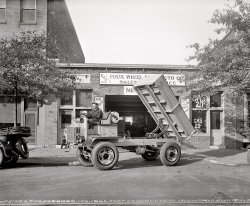
- Feelin' Groovy: 1909
- ... I thought was just a gourmet food store until I started hunting down the spot to get the same perspective). Below is the same view ... Posted by Dave - 05/07/2020 - 4:10pm -
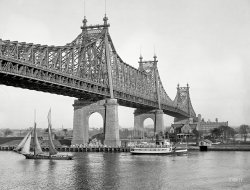
- Wequetonsing: 1906
- ... I'm originally from Michigan, so instead of Helen Keller hunting, my eyes went immediately to the birch trees. I've been in Chicago ... Posted by Dave - 08/02/2012 - 4:13pm -
![Wequetonsing: 1906 Wequetonsing, Michigan, circa 1906. "The birches and the bay." 8x10 inch dry plate glass negative, Detroit Publishing Company. View full size.
Wow! what LUMBER!Check out the thickness of the boardwalk!
[The enthusiasms of our patrons know no bounds! - Dave]
Steamers Comin'I really like that steamer coming in right in the center!
Illusion of SummerWonderful, warm photo. The young lady on the left is a master touch. Not noticed until I went to full size. I wonder if the photographer was aware that she was there?
i·dyl·lic /aɪˈdɪlɪk/ [ahy-dil-ik]Makes my heart yearn for a much simpler time.
Shades of SeuratLooks like the famous Seurat painting, "A Sunday Afternoon on the Island of La Grande Jatte" ...but without the crowd.
WiredWouldn't see the utility lines running right down the beach today! Other than that, what a beautiful setting. between this and the other Michigan beach community photo a day or so back I'm dying for a time machine!
All in a nameWequetonsing, also spelled Wiikwedoonsing, means "the place of the little bay" in Ojibwe and related Ottawa language.
Miracle in the WorksMiss Annie Sullivan is shown enlightening her pupil, Miss Helen Keller.
Quality RespondersIf that is indeed Helen Keller and Annie Sullivan then this blog is nothing less than amazing. The alertness of the commenters is outstanding.
[Ummm ... - Dave]
Preserved in amberWequetonsing is still a lovely place, found just off the main drag of M113 on the way to Harbor Springs. Still a pretty exclusive place and not that far from Bay View, which was featured here very recently. Both places are essentially time capsules.
No Time Machine neededJust point your car north and follow any of the Michigan coastlines. There are still plenty of small, idyllic towns and beaches to enjoy, now with less coal smoke! I'd recommend waiting for summer, however, if you plan on reliving this particular scene.
Not Helen KellerIf the date of the photograph is correct, the couple in the middle of the pic are not Ann Sullivan and Helen Keller. Keller was 26 years old in 1906.
Those birch bark cuttersI'm originally from Michigan, so instead of Helen Keller hunting, my eyes went immediately to the birch trees. I've been in Chicago almost 30 years, but the once-plentiful birch is almost non-existent here now. Growing up in Michigan, we had them; and yes, as kids we took knives to the trees to cut the bark, just like in the picture. I'm adding a picture taken very near the Chicago street I now live on. Rogers Park, Chicago had a lot of birch at that time (early 1900s), and just like in the other picture, everyone cut bark from the trees. The cross street near my house is even named ... Birchwood.
(The Gallery, Boats & Bridges, DPC, Travel & Vacation)](https://www.shorpy.com/files/images/4a13064a.thumbnail.jpg)
- Gone Fishing: 1952
- ... area that any of us, and gets to hear all of the amazing hunting, fishing and human interest stories from the locals.
(ShorpyBlog, ... Posted by SynapticCleft - 06/29/2010 - 9:31am -
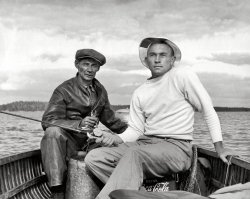
- Red Owl Supermarket
- ... one of two watering holes in the town.
Pheasant hunting was one of the major economic engines, with hunting parties from all over the US, often staying with farmers in the area - ... Posted by 4allofyou - 09/20/2011 - 1:41am -
![Red Owl Supermarket I received a lot of negatives from people in the U.S. This negative came together with a lot from New Orleans. I don't know the place. In the background I can see the Red Owl Supermarket. View full size.
Redfield, South DakotaAccording to a 1951 article in the Huronite and Daily Plainsman by the mayor of Redfield, Harlan P. Packard was one of the town's "first two bona fide settlers." He lured the State School and Home for the Feeble Minded (now called the South Dakota Developmental Center) to greater Redfield. "It is his name that is most indelibly linked with the city and its subsequent progress." The hotel, then the oldest building in town, is now gone. The Dakota Cafe building seems to remain, "renovated" into a hardware store.
Harlan Packard HotelGoogling turns up references to a number of (outdated, unfortunately) eBay listings for a postcard showing a Harlan Packard Hotel in Redfield, South Dakota, plus a listing in the Hotel & Motel Redbook for 1968 indicating an establishment by that name at the corner of 6th Avenue and Main in that city. Also, in the photo, note what is pretty surely the Dakota Cafe on the corner, and Redfield had one of those.
Harlan Packard HotelHow did you manage to find these answers because I couldn't.
[Google Books search. - Dave]
Dakota CafeThanks for your help, this is how the building looks today.
View Larger Map
Signal LightThe light on top of the Harlan Packard Hotel was the police signal. If you needed the police, you would call the telephone operator, and she would turn it on, and then you could call the telephone office to find out what the problem was. This method was used until the early 1960s.
Richard Gallup
Redfield, SD
Harlan Packard HotelThe Harlan Packard Hotel was my grandfather's. From the early 1930's until he died in the 1970's. My grandmother would run the desk (the old cable plug in types on the switchboard (remember Lily Tomlin's character from Laugh In?), and my father ran his shoeshine service in the lobby. As a kid I had the greatest pleasure possible -- free soda pop from the bar, and read as many comics as I could at one time.
Attached to the Hotel around the corner was the Prairie Lounge, one of two watering holes in the town.
Pheasant hunting was one of the major economic engines, with hunting parties from all over the US, often staying with farmers in the area - the original bed and breakfasts? - if not staying at the Harlan Packard.
Also important is the cafe next door. All the farmers within a very large radius chose to come to town every Thursday to get groceries, supplies, and a great deal of socialization. My treat was a bowl of mashed potatoes and gravy at the cafe -- no ice cream or other desserts, excepting perhaps a piece of pie -- and no comfort good could possibly have been better.
This was a small town of ~ 1200 when I was a boy, and it really hasn't changed a lot since except for new building facades, and of course, newer vehicles.
If you still have this photo, I would be interested in obtaining it. I don't hold much hope you do, since the last posting from you was in 2009.
What a wonderful picture and the memories it sparked.
Paul Blackburn
Phoenix AZ 85048
pablackburn@cox.net
(ShorpyBlog, Member Gallery, Eateries & Bars)](https://www.shorpy.com/files/images/img025_0.thumbnail.jpg)
- Top Shelf: 1942
- ... project. Shopping in the cooperative grocery store." Hunting for that last can of Spam. Photo by Marjory Collins for the ... Posted by Dave - 03/20/2014 - 11:58am -
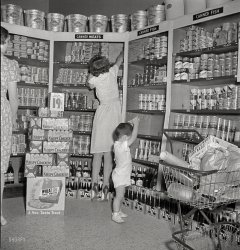
- Thresher Parade: 1941
- ... out wandering the coutry Remember as a kids we'd be hunting, hiking, goofing off in the country and seeing these rusting hulks out ... Posted by Dave - 04/07/2022 - 12:14pm -
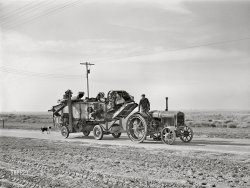
- Here Comes the Neighborhood
- ... good, solid houses that should still be around, so I went hunting on google/bing maps but came up empty.
Of course, numbered streets ... Posted by Dave - 09/04/2012 - 4:56pm -
![Here Comes the Neighborhood Washington, D.C., circa 1921. "Dunigan auto." The residential developer D.J. Dunigan with some of his creations. In back is the house we saw earlier today. The car is a circa 1921 Velie Six. National Photo Co. glass negative. View full size.
Velie sedanI think the car is an early 1920s Velie, a car made in Moline, Ill., by a cousin of John Deere, who invented the steel plow. Closed sedans were a luxury in the early days when most cars were open tourings or roadsters.
It might be a GardnerThe car looks like a 1920 or 1921 Gardner sedan, but I'm not positive.
Car IDI win! That's old man Dunigan's car.
The new closed VelieVelie seems to be the correct answer. This car had hundreds of ads in the Washington Post from 1910 to 1928. Maybe D.J. saw it on display at the Wardman Park Hotel "Closed Car Salon" -- click below to enlarge.
Velie MotorsVelie built 250,000-300,000 cars from 1909 until 1928, of which a couple hundred still exist.
The company also built aircraft and aircraft engines for several years. Its airplane business was sold and moved to St. Louis after Velie Motors closed, building Monocoupes until 1950 or so.
Velie Motors ended production of automobiles in 1928, a year before the death of company founder Willard Velie, a grandson of John Deere.
The front wall of the old Velie Carriage Works is all that remains, incorporated into the perimeter around the John Deere Planter Works on River Drive in Moline.
Where the streets have no nameThese look like good, solid houses that should still be around, so I went hunting on google/bing maps but came up empty.
Of course, numbered streets in DC are totally bizarre (18th, for example has a NE, NW and SE, and they start and stop and random locations), so it's not exactly simple. I don't envy the Washington postal carriers.
[The ever-resourceful Stanton Square found these houses on 16th Street NW in the previous post. - Dave]
Edit: Ah, thanks, missed that. They sure look smaller now than the old pix, but in nice condition.
View Larger Map
Love to find the car today.....Being able to see the house 82 years later via something that was never even dreamed is just beyond NEAT!
Love this website!
Why two?Ok, so it is a Velie, but why are there 2 license plates on the front and back?
[Back before the reciprocity laws, motor vehicles had to licensed in every state they were driven in. - Dave]
NomenclatureHow neat that the two door Velie sedan was known as the "Sociable Coupe"! I wonder if it had a bar in the back?
How gaucheIf there's anything I can't stand, it's dirty whitewalls.
Scary windowsThe cottage for sale has those scary quarter-round windows that will forever haunt me from the Amityville movies.
NeighborsI live two blocks from these houses. They're bigger than they appear, around 2,500 square feet and still in great shape.
(The Gallery, Cars, Trucks, Buses, D.C., Natl Photo)](https://www.shorpy.com/files/images/30239u.thumbnail.jpg)
- The Hunt: 1918
- Washington, D.C., or vicinity ca. 1918. "Hunting scene" is the not terribly specific label for this sporting view. ... Westminster or Monkton. This area has long history of fox hunting.
(The Gallery, D.C., Dogs, Harris + Ewing, Horses, Sports) ... Posted by Dave - 04/09/2013 - 9:44am -
![The Hunt: 1918 Washington, D.C., or vicinity ca. 1918. "Hunting scene" is the not terribly specific label for this sporting view. Harris & Ewing glass negative. View full size.
Somebody has to say it"The unspeakable in full pursuit of the uneatable." - Oscar Wilde
Ya Got MeI guested at several DC-area hunts in the '60s and '70s, and the stable shown is unfamiliar to me. I assume that the riders shown are Master of Hounds, Whipper-In, etc., but they'd have been dead or about to be by the time I came along. [The hounds ("don't call those hounds dogs!") are typically fetching, but just as typically too similar in facial characteristics to permit physiognomy.] Thus do perish seemingly indelible social influences; for all I know, they don't even play polo at Woodlawn any more.
MaybeMight be Dunblane at Tenley Circle in D.C. altho that hunt had moved out to the Chevy Chase Club by 1918.
Could be the Maryland horse country, near Westminster or Monkton. This area has long history of fox hunting.
(The Gallery, D.C., Dogs, Harris + Ewing, Horses, Sports)](https://www.shorpy.com/files/images/SHORPY_15323a.thumbnail.jpg)
- Break Room: 1940
- ... Keeping feet warm and dry since 1911. L.L. Bean's Maine Hunting Shoe. Leon Bean invented them and they were his first product. The ... Posted by Dave - 11/04/2020 - 9:44am -
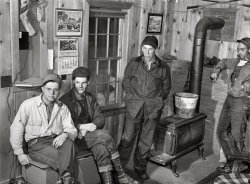
- Choking the Chicken: 1943
- ... started in 1930 when two brothers and an engineer built a hunting trailer for themselves, which attracted the attention of other hunters. ... Posted by Dave - 07/05/2015 - 6:43pm -
![Choking the Chicken: 1943 August 1943. "Middle River, Md. Farm Security Administration housing for Glenn L. Martin aircraft plant workers" is the general caption for this group of photos by John Collier. Unfortunately there are no specifics as to what exactly is going on here. Comments now open for alternate-title suggestions. View full size.
Rejectedbecause it's just so obvious - "Choking the Chicken"
[Since this does indeed seem to be a chicken (of the Barred Rock variety), we are changing the title from "Trussing the Turkey" forthwith. - Dave]
Well --What would you do if your turkey got wet?
It's what's for dinnerIt looks to me like they are having pheasant for dinner. Or maybe it's a game hen.
Bad Day at Barred RockIt appears to me that the gentleman is using a commonly used method to dispatch his Barred Rock hen - secure the feet to a clothesline to immobilize the bird then either slit the throat or cut the head off. The bird will flop briefly then bleed out cleanly.
Tomatoes on the sideTomato plants in the background are bearing nicely. Except for the trailers, this could be my Grandmother’s West Virginia back yard in the 1930s-40s.
Loser, Winner, Chicken DinnerThe days when "fresh" was not signage over an aisle of the grocery store.
Any trailer aficionados?My guess is they are Curtis, but it is just a guess based on the aircraft factory theme.
Dressed for the occasionHe wears his belt buckle to the side so it won't catch on the feathers.
[Buckling to the side was evidently a thing back in the 1930s and '40s -- See 1, 2, 3, 4, 5, 6. - Dave]
Fashion Follows FormMy dad always wore his buckle to the side, and explained to me that he wore it that way so as not to scratch the fender when working on his car. (fenders were big obstacles to engine access in the 30's and 40's)
So; to paraphrase jimboylan's comment below - which inspired mine - "Dad wore his belt buckle to the side so it wouldn't scratch the fenders."(!)
Standard operating procedureHe isn't "choking" the chicken, he is in process of cutting its head off! This was a standard way of butchering chickens in the South while I was growing up. I can recall many times that my mother butchered a half dozen chickens by tying their feet together, hanging them from the clothesline, taking their heads off with a very sharp butcher knife, and running like hell to keep from getting spattered with the blood that flew around while the chicken flapped as it bled out. Basically it was/is a very clean way of butchering chickens, as they bleed out quickly.
Twist-OffMy mother used to tell me of a slightly more gruesome method her mother (Grandma) had of just picking up the chicken by the head and spinning it around a couple of times until the head twisted off. Of course the chicken would run around a bit without its head. This story terrified me as a kid.
More on Buckle PlacementBuckle to the side keeps him from scratching the back of his guitar while playing in local rockabilly band.
Buckles to the sideMy contemporaries and I in our pre-teen and early teen years were wearing our buckles this way, especially for what we called "garrison belts", in the 1950s. This for some of the same reasons cited, but we thought it was just being "cool", like rolling up the bottom of our dungarees six inches. Mom always bought 'em too long so we could grow into them.
Pumping gasBack in the 50's I had a part time job at a Marathon gas station and the boss made me wear my belt on the side or tuck a shop rag over it to eliminate scratches on customer cars when checking oil or cleaning windshields. Yeah,,,,we really did that folks!
Killing the ChickenOne of the most interesting things my brother and I were privileged to behold when we spent a few weeks with Grandma in small-town Southern Illinois in the late 1950's, was the killing of chickens in precisely this way. The lady across the street raised chickens in her back yard and about once a week would dispatch a fair number of them all at once, probably to sell. She would tie up about 3 hens per bunch and then hang up 4 or 5 bunches on her clothes line. Then she would take a big knife, grab the heads and cut them off. We were very impressed since we lived in a medium-sized town in Michigan where no such thing could be imagined. Chickens for us were wrapped in plastic - nice and neat. This picture brought back a wonderful memory. What's the matter with me?
Were these the good old daysAs mentioned by PopCollector I have often seen my Mother kill a chicken by wringing its neck and letting it flop on the ground to bleed out. In the 40's ( maybe early 50's ) our local grocery store bought live chickens from local farmers. The store would truss the chickens up by their feet and have them hanging upside down on a rack in the storeroom. A customer could go back to the storeroom and pick out a chicken to take home where the chicken would be dispatched, dipped in very hot water, plucked, gutted, dismembered, and cooked. Mom could sure cook up some good fried chicken but I sure wouldn't want to go that route myself. Give me something already cut up in a plastic wrap to cook.
Killing humanelyFried chicken on the dinner table requires several preliminary steps. Hanging the chicken upside down calms it considerably before the incision as blood rushes to its head, and allows it to bleed out as quickly as possible. In the hands of a skilled butcher the death of the chicken is humane because it is virtually instantaneous.
No Irony HereI like tommydo's sense of humor, but those are not Curtiss trailers. Each one is a 1941 Silvermoon Model 7000 (later Model 70) made by the Alma Trailer Company in Alma, Michigan. Their color was olive drab green and gray, and both the two and the four-person versions rented for $6.50 a week
The company started in 1930 when two brothers and an engineer built a hunting trailer for themselves, which attracted the attention of other hunters. Soon after a company was formed and they became busy enough to move into an abandoned Republic Truck factory. When an investor gained a majority of the stock in 1937, the original three left and started the Redman Trailer Company (named after the two brothers). They called their competing product the New Moon, and they set up shop directly across the street in an old Libby's pickle canning plant. Sales took off when they began offering a trailer that was significantly longer than others in the market.
Both Alma and Redman (along with others) supplied the Farm Services Administration with housing (Silvermoons and New Moons, respectively) during the military build-up before the United States entered WWII. Redman also supplied military trailers and hospital units during the war. By 1944 the Redman Company had completed their war contracts and were being allowed to once again build and sell a few of their trailers—but only to workers engaged in the war effort.
After the war both companies experienced a sales boom, with Alma Trailer Company peaking a few years later. In 1952 Alma began to lose money and continued to do so until production ceased around 1960, while Redman went on to greater fame and fortune by switching from trailers to mobile homes. In 1953 The Long, Long Trailer hit the big screen and became MGM's biggest comedy up to that time, while the New Moon Mobile Home featured in the movie became a best seller.
Now headquartered in Dallas and known as Redman Homes, they are the second largest builder of manufactured housing in the country.
(The Gallery, John Collier)](https://www.shorpy.com/files/images/SHORPY-8d32273a1.thumbnail.jpg)
- Cafe Texaco: 1950
- ... . The walls are covered in old photos, old fishing and hunting gear, etc. There's a store, bar and cafe , and cabins for rent on ... Posted by Dave - 03/06/2021 - 4:32pm -
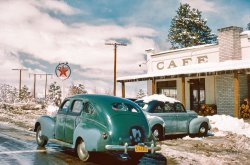
- Maplewood Lodge: 1902
- ... Git a Man With a Gun That man with the gun and hunting dogs was George Finnigan. I wonder if he lived in that magnificent, ... a hunter’s delight specializing in the sport of hunting partridge, woodcock, squirrel, grouse, rabbit and fox., heavily ... Posted by Dave - 08/27/2014 - 2:15pm -
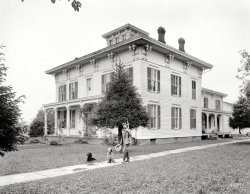
- Cranked: 1937
- ... where many have summer homes/cabins and where the deer hunting culture is king) as a Wisconsin town can be. And, it should be pointed ... Posted by Dave - 12/11/2012 - 4:45pm -
![Cranked: 1937 April 1937. "Bureau in the bedroom of the house occupied by the Ingrahams and the Smallwoods near Nelma, Wisconsin." A cryptic tableau if there ever was one. Medium-format nitrate negative by Russell Lee. View full size.
Way "Up North"As a native Wisconsinite, I can honestly say that I have never heard of Nelma, WI, which appears to be a speck on the map.
Nelma is about as far "up north" (a term used by natives to refer to the northern lakes and forest areas of the state where many have summer homes/cabins and where the deer hunting culture is king) as a Wisconsin town can be. And, it should be pointed out, that the Ingrahams's and Smallwood's home is only "near" Nelma, which makes it even further removed from civilization. The paper on the bedroom walls gives new meaning to the term "wall paper". (Let's hope that there is some insulation under it somewhere as the subzero temperatures in this neck of the woods can be extreme.) The artwork on the wall appears to be Dutch, but is not Vermeer. The bottles under the dresser could have contained liquor or liniment, both of which would have been necessary to survive life in Nelma. I don't want to think about the possibilities of why the hammer was lying side-by-side with a pair of boy's shoes. In addition, one can only hope that the two families were able to survive the seven years' bad luck that may have come as a result of the breaking of the mirror. As Dave stated, this indeed is a cryptic tableau.
Old-school audioIn strictly temporal terms, playing a cylinder in 1937 would be like today sticking one of those round, silvery things - what are they called again? Oh yeah, CDs - into a machine rather than downloading or streaming an mp3 to your mobile device.
Unless I'm MistakenThis tableau is one of the sets for Edison's lost 1909 version of The Shining.
Functionality of wallpaperIn response to LilyPondLane's submittal: In our modern times, wallpaper is merely a form of wall decoration. Formerly, wallpaper had a utilitarian function to seal the interior space of the house, and prevent drafts. Many houses did not use sheetrock or plaster on the walls, and cold air could seep in past the wood siding and planking.
Copyright InfringementI'd say this is a crime scene photo -- of a cylinder bootlegging operation!
Why?My question is, why is there even a photo of this scene? It may be interesting to look at 75 years later but I doubt in 1937 it was that impressive.
[It is one of the many thousands of pictures taken by Russell Lee and his colleagues documenting housing conditions for the Farm Security and Resettlement Administrations. - Dave]
This is so wrong to sayJudging by those empties and what else is scattered on that floor, I'd say someone got hammered last night. Well, I did say it was so wrong to say.
WallpaperAs an illustration for the utility of wallpaper as described by MaxCohoon, I have attached two photographs from the same series that show the house from the outside. It is constructed of logs. The caption for the detail photograph reads in part: "Note the earth fill around base to keep in warmth in the winter. The space between the logs is usually filled with cement or mud. The windows are removed when a house is abandoned; people cannot build glass."
Old AudioEdison actually made cylinders until 1929.
From a Victrola collectorThe mechanism looks like an Edison Amberola 30, but that cabinet is spartan. I'm not sure what the model number is without the ornate oak cabinet.
Edison Amberola 30Agree with Michael that the machine is an Edison Amberola 30. The "-ola" suffix referred to an internal horn machine [Victor = Victrola, Columbia = Grafonola, etc.], and the cylinders made for use on the Edison machines were known as "Blue Amberols".
Regarding sstucky's comment, Edison did make cylinders until the fall of 1929, by which point they were recorded using the electrical, rather than acoustical, recording process. Although cylinders had long since fallen out of favor with the record-buying public at large, Edison continued to produce them on the basis of many rural folks still having the older machines--this photo is a good indication of that marketing strategy.
Ola!Victor claimed they chose the suffix -ola for their new internal horn machine because it had "a sound suggestive of music". Suggestive of music, perhaps, in that it was quite suggestive of another company's product: Aeolian's brand of player piano, the Pianola. Swiping other people's suffixes isn't without its poetic justice, and soon other phonograph companies began coming out with their own "olas" (actually the "o" was part of the word "piano"). Eventually an auto parts company, which had never manufactured pianos or phonographs, would appropriate it as a name for their new car radio, a name that's still around today.
(Technology, The Gallery, Russell Lee)](https://www.shorpy.com/files/images/SHORPY_8b30346a.thumbnail.jpg)
- Rabbit Jump: 1916
- ... when jumping.
(Henry Thomas Alken "Fox hunting")
Example of military fork seat over fences.
At the ... Posted by Dave - 08/27/2012 - 2:40pm -
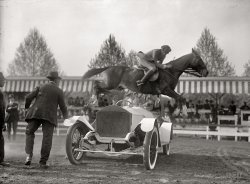
- White Hunter: 1900
- Circa 1900s. "Billy and his mistress in hunting poses." One of eight curious portraits of this statuesque pair, who ... Posted by Dave - 11/23/2010 - 6:23pm -
![White Hunter: 1900 Circa 1900s. "Billy and his mistress in hunting poses." One of eight curious portraits of this statuesque pair, who appear almost whitewashed. 8x10 inch dry plate glass negative, Detroit Publishing Company. View full size.
All in the familyI'm sure both of them are related to Oscar Wilde.
WTH?Now why would the photographer compose the picture to include the ratty, tattered end of his ripped backdrop cloth? Even cropping tight wouldn't disguise all of it. Those things are supposed to be seamless, and without holes.
[My guess is that the backdrop will be masked out, and that the end product is in color. - Dave]
In The Olden DaysWas it normal to appear ridiculous?
CamouflageMust be winter!
Where's Groucho? Looks like Harpo before the harp. Or maybe that's what's in the flask.
Here Snowball,You can go chew on this G4 phone. I can't figure it out. It will be much easier to have a good stiff drink and then just send a telegram.
"On the Trail"I wonder if the attached image is a finished card from the same series? There are some strong similarities, but also a good bit of artistic license.
[Similar theme, but not the same series of pictures. Also a different model. - Dave]
Can't wait for the other sevenI find Mistress quite shapely and appealing.
That's why all the white>> My guess is that the backdrop will be masked out, and that the end product is in color
That's why everything's white -- it makes it easier for the colorist to get the colors right. It's an early version of "green screen."
Your next mission, should you choose to accept it, is to find the colorized version. It will probably be an advertising poster, but might be a postcard.
[Okay everyone. Start looking! eBay might be a good place to begin. I agree that what we are seeing here is one of the steps in what would come to be known as photomechanical color or process color. - Dave]
30 seconds with PhotoshopA quick Photoshop paintbucket tool job.
Oh Shoot! She's wearing shot shells on her belt, but that weapon looks to be a breech loading 44-40 or there about. I guess artistic license prevailed.
(The Gallery, Dogs, DPC)](https://www.shorpy.com/files/images/4a16810a.thumbnail.jpg)
- Girl Shooters: 1922
- ... signed me up for a hunter's safety class so I could get my hunting license. I was the only girl in my group! In the riflery portion of the ... Posted by Dave - 08/31/2012 - 4:00pm -
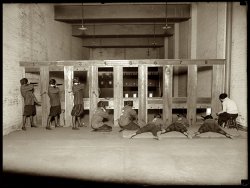
- Doggie Dinner: 1963
- ... time she actually pointed at some lurking critter. That hunting instinct didn't always end well; she tangled with a skunk once, and one ... Posted by tterrace - 11/27/2017 - 1:28pm -
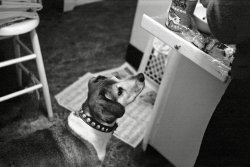
- Glass Paints Oils: 1937
- ... ago.
Three Buckets My father would take me duck hunting in the 50's and we used one in our duck blind to stay warm.The small ... Posted by Dave - 09/02/2013 - 1:36pm -
![Glass Paints Oils: 1937 Circa 1937. "Hardware store, 906 Bourbon Street, New Orleans." Carrying a full line of protectants and preservatives, none of which seem to be suitable for the store itself. 8x10 acetate negative by Frances Benjamin Johnston. View full size.
Those bucketsI see little sliding doors on the sides, which would appear to cover those holes when slid down all the way. I guess it's easier to slide open a door on a heavy bucket than to tip it over and pour. Seems like there'd be a bit of leakage in these models, though.
[I suspect the holes are for ventilation and that the lining is fireproof. - Dave]
NOLA native says906 is the not the restaurant with the neon (now) but the business next door (to the right) with the red chairs, which is currently listed as a hair salon.
On the corner (going towards Canal St) are the iconic Clover Grill and across the street Cafe Lafitte in Exile which is a really famous gay bar as it claims status at the oldest continuously operating gay bar in North America.
Could be the placeView Larger Map
Back when the Quarter was a neighborhoodRather than a tourist attraction. Real stuff for real people doing real things like painting the bathroom cupboard or replacing a broken windowpane. My former home town of Carmel, CA, went from three hardware stores, five groceries, seven filling stations, and three drug stores in the '50s to zero, one, one, and one, respectively, by the '80s, but boy did we gain some galleries and boutiques!
Three bucketsI thought at first they hold items for sale, but they could have been used to strain the paint that was sold.
Holey bucketsI'm curious: what would the three buckets with holes in them hung on the door frame be used for?
Saulny's storeIn the 1880 census he is one year old, the son of 2 "mulattos", but listed as black in later census years. He's the son of a shoemaker, Louis Saulny, born 1846. Louis's father is also listed as a "mulatto", a carpenter born 1827. He died when he was 31.
Pierre SAULNY was the first Saulny in USA. He was born in Nantes, France. There is a date of birth in 1774. Some data doesn’t match so we take between 1894 to 1800 as his date of birth. He married Catherine DINET (1797-1853) free woman of color native of Pestel on the Island of Santo Domingo, Haiti. They married in New Orleans in 1820 and lived in the Suburb Marigny on Moreau Street between Elysian Fields and Frenchmen Streets since 1822 in a house situated on Esplanade Street between Conde and Royal Streets, until at least 1835. The residence of Catherine Dinet is an area that exists today and was inhabited by many free people of color as well as Creoles of European descent.
Another BarYep, that's exactly where it was, just behind Clover Grill.
I think Kozel is rightComparing the position of the window (closer to the door on the right), and the shape of the jamb, sills and lintels, I'm pretty sure the building with the neon is correct. The original photo shows a full length porch on top which is now separate balconies, but the side of the building still has porches which may indicate the front had the same ones.
Or, it could just be 907 across the street, which still has the upper porch in the right place.
[Below, 907-909 Bourbon Street. - Dave]
John McCrady School of Fine ArtsI went to art school in that white building that kozel posted. I believe I remember Mrs. McCrady saying that it was a hardware store before it was the school. But that was over 30 years ago and memories fade and Mrs Mac died long ago.
Three BucketsMy father would take me duck hunting in the 50's and we used one in our duck blind to stay warm.The small door would let more air into the fire. Worked really good when you were freezing.
(The Gallery, F.B. Johnston, New Orleans, Stores & Markets)](https://www.shorpy.com/files/images/SHORPY_01208a.thumbnail.jpg)
- Scenic Petoskey: 1908
- ... on food freezers because of the predominance of their hunting population and that helped them get through the summer. That I still ... Posted by Dave - 07/29/2012 - 6:12pm -
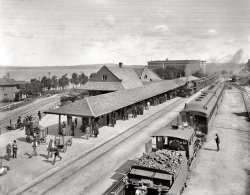
- Car Noir: 1977
- ... neighbor who was a storm-chaser and always off in the SUV hunting tornados. Always gone when I wanted to mow and always leaving his ... Posted by rizzman1953 - 06/23/2012 - 5:45pm -
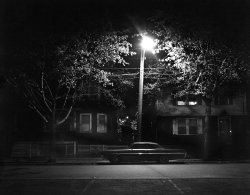
- Jacked: 1942
- ... to keep the flanges off the rail heads and to eliminate hunting. The wheels are pressed onto the axles. This particular car has 33 inch ... Posted by Dave - 08/21/2013 - 2:19pm -
![Jacked: 1942 November 1942. "Chicago, Illinois. Jacking up a car on the repair tracks at an Illinois Central Railroad yard." Someone get the spare out of the trunk? Medium-format negative by Jack Delano, Office of War Information. View full size.
RIP: 1942Delano caught it on one of the RIP tracks. Repair In Place.
Treble MemoryI believe both wheels shared a common axe. So to make a change he needs another jack. Quiz time: why were the outer rims tapered?
[That axe never stops sharpening. - Dave]
Doh!When they told him to go get a Duff he thought they meant Beer.
Not just trucking aroundThere probably is another jack out of view to the left. He'll be removing the whole truck (both axes...er...axles and all 4 wheels). If he was just removing one pair of whhels he'd have to support the truck somehow instead of the frame of the car.
Don't Damage the FinishWe first saw a track jack and Texas toothpick back here. I don't quite understand the padding that seems to be sitting on the business end of the jack.
Tapered wheelsTapered wheels keep the wheels centered on the rails and allow for the different distances each wheel travels when going around curves since they have a solid connection via the axle to the opposite wheel. In an ideal world the flanges should never touch the rails in reality they do however.
Wheel taperWheel taper is 2 degrees 50 minutes. The taper is designed to keep the flanges off the rail heads and to eliminate hunting. The wheels are pressed onto the axles. This particular car has 33 inch wheels and plain bearings. It would be another 20 years before roller bearings were in widespread use on freight cars.
That guy has some "get up and go"Now that's what I call a faith-based initiative!
That JackThat jack is very similar to the ones my father had stored in his garage. He used a couple to jack up the front and back porches on his house (for long term stability). He called them "house" jacks, and I'm sure they are still doing their jobs 60 years after installation!
Trucks and solid axles. With the solid friction bearing axles as in this pictured truck. The truck needs to be disassembled to replace a wheel set (2 wheels and axle). The paper between the jack and steel body is to reduce slipping of the steel on steel surface.
(The Gallery, Jack Delano, Railroads)](https://www.shorpy.com/files/images/SHORPY_8d23268a.thumbnail.jpg)
- All-American: 1939
- ... and passed this spot many times on my way to the beach at Hunting Island State Park. The family that owned it for many years operated a ... Posted by Dave - 07/06/2020 - 10:11am -
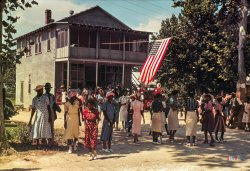
- Cross-Country: 1906
- ... the rifle in the side holster. Or maybe a little game hunting?
[The gun was for wolves. Details in the comments here . - ... Posted by Dave - 08/20/2012 - 2:06pm -
![Cross-Country: 1906 New York, June 1906. "REO Mountaineer, New York to San Francisco and back." Percy Megargel and David Fassett pass Huber's Hotel on 162nd Street in the Bronx at the end of their 10-month, 11,000-mile trip in a 16-horsepower touring car. Note the unpaved street at the present-day location of Yankee Stadium. 8x10 inch dry plate glass negative, Detroit Publishing Company. View full size.
Have we got a spare?Back in those days, before steel belted tires, it was not unusual for cars to experience flat tires every few miles. I wonder how many tires they took with them for that 11,000 mile journey, especially driving through Death Valley.
+59It's the opening of The Great Race.
Ready for troubleIt appears they were ready for serious trouble with the rifle in the side holster. Or maybe a little game hunting?
[The gun was for wolves. Details in the comments here. - Dave]
The suspension is killing meMr. Megargel appears to be suffering a bit in the sacroiliac.
Wore out!Back in those days, a car would need major maintinance after 11,000 miles. Rods and main bearings needed adjusting and valves needed lapping. Most likely these vary things were done on the trip. No telling how many tires and how much oil they went through.
re: +59That was hysterical.
More on their tripCan be found in the comments for the previous post on the trip. Including this article. And interestingly enough, Percy Megargel wrote "The Car and the Lady," a fictionalized account of his journey wrapped in a love story.
Blurred photographerThe young man in front of the car is holding a "portable" camera. Looks like a single lens reflex large format camera. Working pretty much like a Hasselblad, but with much better resolution than a medium format camera like the Hasselblad. Very cool to see such a camera in action.
(The Gallery, Cars, Trucks, Buses, DPC, NYC)](https://www.shorpy.com/files/images/4a21368a.thumbnail.jpg)
- Cottage Chic: 1936
- ... for the fields.
My grandfather used to take me coon hunting in those fields during the late evenings. He'd let the hounds tree ... Posted by Dave - 05/29/2013 - 11:59pm -
